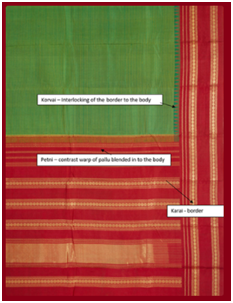One of the most prized gifts to an Indian woman continues to be a richly brocaded Kanchipuram handwoven sari, illustrating the central role of the beautiful drape.
The sheer beauty of the fabulous silks of the South, with jewel-toned colours enriched with threads of gold, has overwhelmed people. Kanchi pattu pudavai always has a special place in the handlooms of India!

In Tamilnadu, the essential parts of a sari are classified into three essential parts –
1. "Mundhani" (or "thalaippu") or pallu, which is the headpiece of the sari, which is the final one and half metres of the saree. The skill of the weavers is highlighted in the thalaippu or pallu.
2. The middle segment is called the "Udal" or body of the sari. It can be plain, have buttis or motifs, checks (Kattams) or stripes.
3. The borders are called "Karai" meaning "boundary"
Kanjivarams, the silk sarees that emerged from age-old traditions and techniques is a must-have for South Indian weddings. The bride wears auspicious colours of “Kumkuma red” or Aracku, “Maragada Pachai (Emerald green), Turmeric yellow (Pasu Manjal) or sheer gold brocades.
It is a mark of auspiciousness that families of to be brides and grooms to date throng Kanchipuram for purchasing the saree to be worn as “muhurta pattu” – the auspicious silk worn while tying a Mangalsutra.

While many handloom weavers across India prefer the tie and dye method to create the contrast, Kanchipuram weavers do it differently. The hallmark is the famous knotting and interlocking technique called “Korvai” – of the border and pallu which are woven separately. Weavers use the ancient craft of three shuttle weaving and interlocking weft to get the effect of "korvai”
A classic Korvai Kanjivaram involves the interlocking of the body yarn and border yarn. If you notice closely, you can see a slightly uneven line looking like a hand stitch where the body and border join. In a Korvai saree, one can see the laborious work of interlocking two different textures of yarn used in body and border. The experience and dexterity of the weaver are showcased in the saree’s finish.
The Petni is the hallmark of a Kanjivaram saree, and this technique joins the contrast and thick pallu to the body of the saree.





